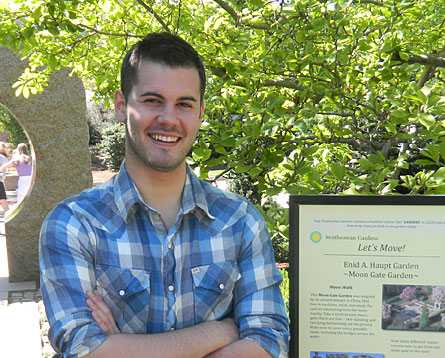College Students Move from the Classroom to the Smithsonian
Imagine spending an internship engaging, designing and educating at the world’s largest museum and research complex. That’s what students from the Art Institute of Chicago, University of Maine and George Washington University did while interning at the Smithsonian—working behind-the-scenes alongside experts in art, history, culture and science.
Jess Park of Chicago interned at the Smithsonian’s Hirshhorn Museum and Sculpture Garden where she worked as an interpretive guide. She helped visitors understand the modern and contemporary art collection. “As an interpretive guide, my main duty was to engage visitors in conversations that establish meaningful connections to modern and contemporary art, and help them arrive at a more complete reading of the Hirshhorn’s special exhibitions and permanent collection,” Park said. She interned at the Smithsonian from September 2011 to January 2012 and is now the Samuel H. Kress Interpretive Fellow at the Portland Art Museum.
Corey Colwill of Farmingdale, Maine, interned with the Smithsonian Gardens’ education and outreach staff. Colwill developed an outdoor treasure hunt for the Smithsonian’s young visitors in collaboration with Let’s Move! with Smithsonian Gardens, part of a White House program to reduce obesity in younger generations. When describing the reach of his work, Colwill said, “People have the opportunity to learn about the collections of the Smithsonian through these programs and relate that information to experiences in their own communities.” Colwill interned at the Smithsonian from September 2011 to January 2012 and is working on his master’s degree in history from American University.
Catherine Sigmond of Lafayette Hill, Pa., a two-time intern at the Smithsonian’s National Museum of Natural History’s Human Origins Program, developed activities and displays to educate visitors about human evolution. She improved the program’s educational efforts by analyzing visitors’ questions posed to the scientists at interactive kiosks in the exhibit. Sigmond interned at the Smithsonian from October to December 2009 and September to December 2010; she is now living in Marseille, France. Sigmond said that she is “applying to graduate programs in Museum Education and Anthropology—something that is in large part due to my fantastic experience at the National Museum of Natural History.”
Approximately 1,200 interns participate each year in various programs throughout the Smithsonian. Park, Colwill and Sigmond offer the following tips to their peers when applying for an internship:
- An internship is the perfect opportunity to explore new career options, so make the most of your limited time by scheduling informational interviews with staff outside of your department. Keep these meetings to 20 minutes, prepare a list of specific questions in advance and thank the interviewee for his or her time with a handwritten note. (Park)
- Always ask questions. The best way to progress in your internship is to continually ask your coworkers questions. You should never feel ashamed for not knowing something. Most likely those you ask will be happy to answer and possibly provide you with more information than you were seeking! (Colwill)
- Do what you are not asked to do. Don’t be afraid to go that extra mile and take on more responsibilities than what’s being asked of you. Employers really value self-motivation, and when they see that you are willing to do more than what is required without being asked they will appreciate it. As a result, they’ll probably give you more responsibility and trust you with more important (and interesting!) projects, which will make your internship experience so much more worthwhile. (Sigmond)
To learn more about Smithsonian internships, visit http://www.si.edu/interns.
Founded in 1846, the Smithsonian is the world’s largest museum and research complex, consisting of 19 museums and galleries, the National Zoological Park and nine research facilities. The total number of objects, works of art and specimens at the Smithsonian is estimated at 137 million.
# # #
SI-202-2012




